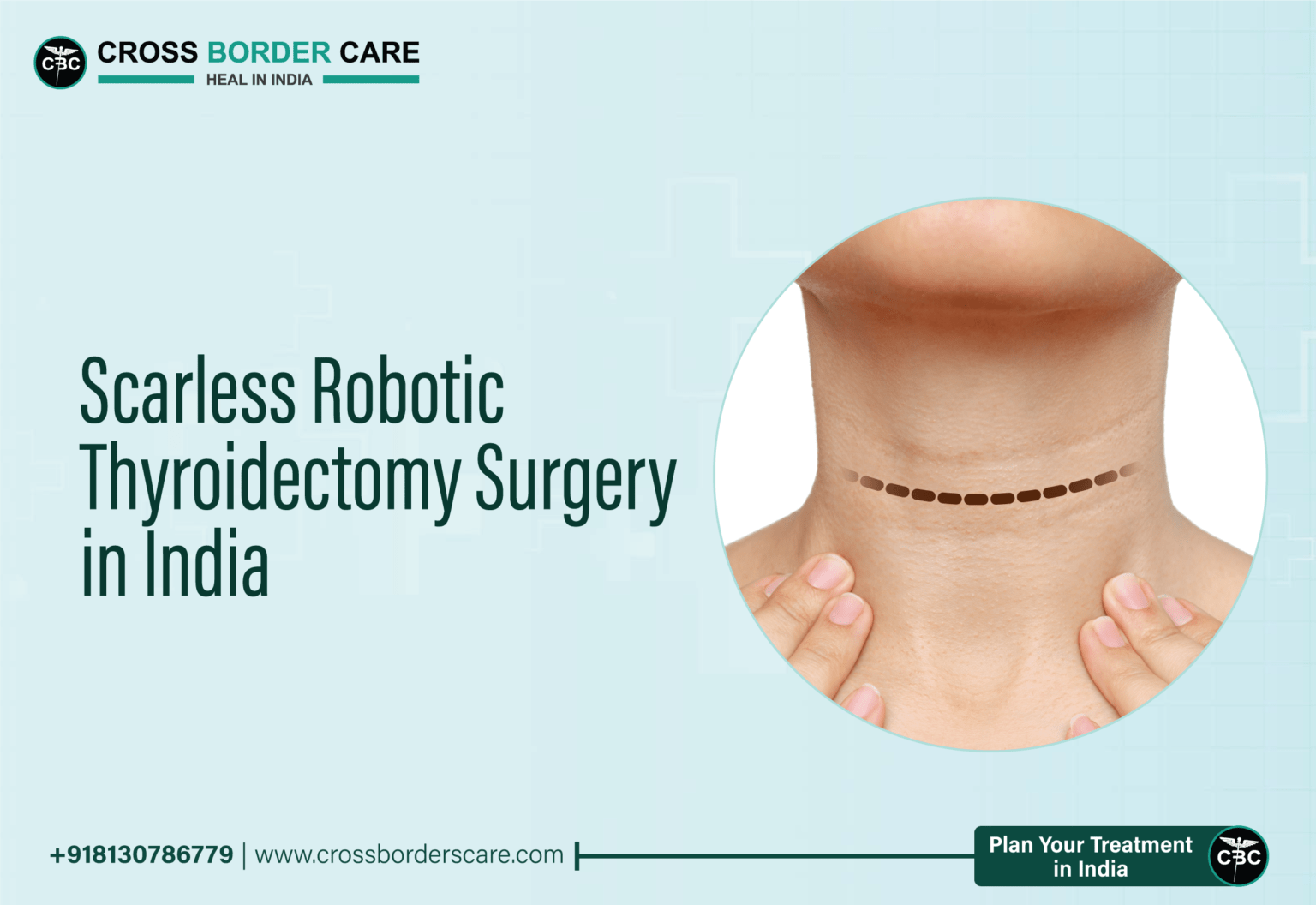The thyroid gland is a small butterfly-shaped gland that is located in the front of the neck and it produces hormones that regulate the metabolism of the body. Thyroidectomy is the surgical removal of all thyroid glands or only a part of it. The surgery is performed for the treatment of thyroid cancer, hyperthyroidism and other thyroid-related conditions. The surgery involves the removal of the full thyroid gland or only a part of it depending on the extent of the disease. Traditionally the surgery was performed using a conventional approach but in recent years, a more advanced approach is used that leaves no incision marks. In this blog, we will discuss Robotic Thyroidectomy Vs Conventional Thyroidectomy the difference between the two approaches, the pros and cons of both types of surgeries and more. Knowing the difference between the two procedures is important when deciding the best treatment option for yourself. Continue reading to know more about them.
Robotic Thyroidectomy-What is it?
Robotic thyroidectomy is a minimally invasive surgery that uses a robot to perform the procedure by making tiny incisions in the neck. The robot receives the instructions from the surgeon and then brings them into action. The surgeon sits at the console and operates a computer to move the robotic arms that are equipped with cameras and surgical
instruments. This form of surgery has a high rate of success, all thanks to the da Vinci surgical system that has brought a complete transformation in the field of medical science. It is an ideal solution for people who do not want a visible scar on the neck after the surgery.
Advantages of Robotic Thyroidectomy
The main advantages of robotic Thyroidectomy include:
- Small Incision: This is the biggest advantage of robotic thyroidectomy as it involves a very small incision on the neck. It means less scarring and comparatively faster recovery than the conventional approach.
- Better Cosmesis: The small incision that is made using robotic thyroidectomy is generally made behind the ear or below the armpit which is not visible at all. Therefore, the surgery gives better cosmetic results as compared to manual thyroidectomy.
- Fewer Complications: Robotic Thyroidectomy is a less invasive procedure, thus there are lower risks of complications like no infection, less bleeding and minimum damage to surrounding structures like vocal cords and parathyroid glands.
- Better Visualization: The cameras fitted in the robotic arms of the da Vinci system provide a 3D view of the thyroid gland to the surgeons, as a result of which they can manipulate the thyroid gland more efficiently than with conventional thyroidectomy.
- Short hospital stay: Patients who get robotic thyroidectomy recover fast due to which their hospital stay is of shorter time span.
Potential Disadvantages of Robotic Thyroidectomy
- Accessibility: Robotic Thyroidectomy may not be the perfect procedure for people who have very large thyroid nodules or complex tumours.
- Cost: Cost is a major disadvantage for people who want to get their tumours treated without burning a hole in their pocket. The cost of robotic thyroidectomy is high due to the use of specialised equipment.
- Long Operative Time: The time taken to perform robotic thyroidectomy may be longer as compared to conventional surgery because it takes time to set up and calibrate the robotic system.
When is it preferred?
- Incisions are smaller with robotic thyroidectomy, so there are fewer scars compared to conventional thyroidectomy. This may be particularly helpful for patients concerned about cosmetic outcomes.
- For patients with small thyroid nodules or tumours located in easily accessible neck areas, robotic thyroidectomy might be a good option. By using robotic surgery, thyroid tissue can be removed more precisely and nearby structures can be protected from injury.
- A robotic thyroidectomy might be better for patients more prone to complications. For instance, patients who have had previous neck surgery, have scar tissue or have an enlarged thyroid gland may benefit from a robotic thyroidectomy.
- For people who want a more precise surgery, robotic thyroidectomy is the perfect option for them.
Ultimately, the decision to undergo robotic thyroidectomy should be made on a case-by-case basis, after a thorough evaluation by a healthcare provider. The surgeon will consider the patient’s medical history, the size and location of the thyroid nodule or tumour, and the potential risks and benefits of each approach before making a recommendation.
Conventional Thyroidectomy-Know what is it?
Conventional thyroidectomy, on the other hand, involves making a large incision in the neck and then the thyroid gland is removed manually by the surgeon. The complete procedure is performed under general anaesthesia and is perfect for people with thyroid nodules and an overactive thyroid gland.
Advantages of conventional thyroidectomy
There are several advantages of conventional thyroidectomy too. Here are some of the advantages:
- Widely available: It is a common approach used in the treatment of thyroid cancers. It is readily available in all hospitals, unlike robotic thyroidectomy which is only available in specific hospitals.
- Less operative time: Conventional thyroidectomy takes less time to perform. It might be a better option for people who are not able to tolerate longer surgical procedures.
- No complex equipment: Conventional thyroidectomy can be performed without any use of specialised equipment or training. Almost all surgeons can perform it without any additional investment or training.
- Less Cost: It is less expensive than robotic thyroidectomy as no special equipment is required. It is more beneficial for the patients who are more concerned about the costs.
Potential disadvantages of conventional thyroidectomy
- More scarring: This surgical procedure involves a large incision in the neck that results in more scarring. The healing time is also comparatively longer.
- More Complications: Conventional thyroidectomy carries more risk of complications like infection, bleeding and damage to surrounding organs like vocal cords and parathyroid glands.
- Long hospital stay: People who undergo conventional robotic thyroidectomy need longer hospital stays compared to the one who undergo robotic thyroidectomy.
When is it preferred?
There are some situations where a conventional thyroidectomy is better:
- Some patients may not be good candidates for robotic thyroidectomy because of their medical history, the size or location of their thyroid gland or tumour, or other factors. Conventional thyroidectomy might be a better option in these cases.
- A thyroid nodule or tumour that is too large or in a complicated area of the neck may be hard to remove using robotic surgery. If this happens, a conventional thyroidectomy may be a better option since it allows the surgeon to see the surgical site clearly and remove the affected tissue more easily.
- Robotic thyroidectomy isn’t available in every hospital or medical centre, especially in rural or underserved areas. You might have no choice but to have a conventional thyroidectomy in these cases.
- Some patients prefer conventional thyroidectomy over robotic surgery, either because of cost concerns or perceptions of the procedure’s invasiveness. It’s possible that the surgeon will recommend a conventional thyroidectomy in these cases.
Comparison of Surgical Outcomes of Robotic Thyroidectomy Vs Conventional Thyroidectomy
The decision regarding the operational procedure depends completely on the preference of the patients. The factors that affect the surgical outcomes of both procedures are:
- Age
- Sex
- BMI
- Extent of Surgery
- The extent of Lymph node dissection
- Tumour size
- Multiplicity
- Bilaterality
- Extrathyroidal Extension
- Stage of the cancer
Robotic Thyroidectomy is not preferred in patients who have a tumour size greater than 4 cm or whose tumours are located on the dorsal aspect of the thyroid with suspicion of invasion to surrounding organs like the oesophagus, trachea or laryngeal nerve. A detailed study shows the following differences between the two procedures:
- The operation time is longer in Robotic Thyroidectomy and the amount of hospital cost was also higher.
- The postoperative pain score is less in the people who underwent robotic thyroidectomy as compared to the people who underwent conventional procedures.
- The parathyroid gland is more likely to be saved in Robotic Thyroidectomy.
- In a robotic thyroidectomy, the number of lymph nodes retrieved is lesser than the number retrieved in a conventional thyroidectomy.
- TSH-stimulated tg is an important clinical parameter that decides which surgery is better. The studies show that robotic thyroidectomy shows more surgical completeness as compared to conventional thyroidectomy.
The aim of this is to make you understand major difference between Robotic Thyroidectomy Vs Conventional Thyroidectomy. Ultimately deciding which surgery will suit you depends on case-to-case basis and also depends on the medical history of the patient. Contact Cross Border Care and we will help you in deciding which approach will best suit your needs. Our team includes experienced medical professionals who will be there with you at each step of your treatment. So, if you are planning your thyroid cancer treatment in India fill out the form below and we will help you to choose the best doctor and hospital providing state-of-art-technology.
May 4, 2023



















